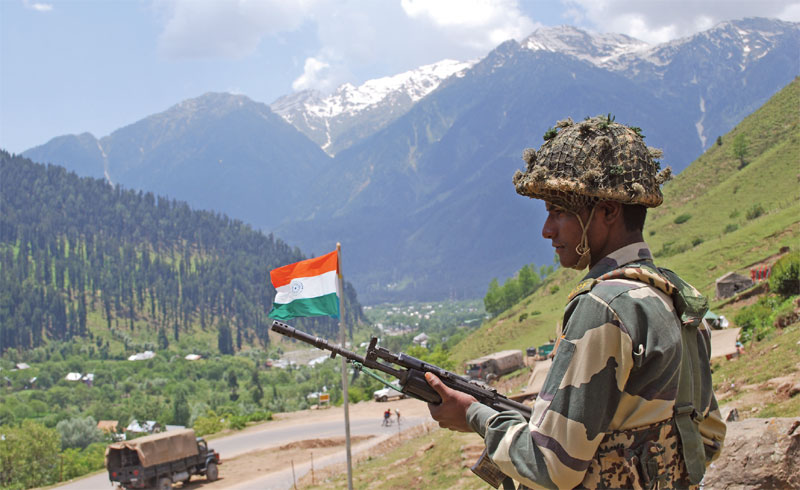To Build a Fortress
Mohammad Asif Khan
Following Chinese incursions into eastern Ladakh in April 2020, India recognised the necessity for effective border technology and surveillance drones to prevent incursions and protect its land borders and coastline. Traditionally, India’s focus on border management was predominantly on security. With borders shared with seven different countries, primarily demarcated by man-made boundaries rather than natural features, India faced unique challenges.

After gaining independence, the responsibility of border security initially fell upon state forces. However, due to certain inadequacies, the Central Armed Police Forces (CAPFs) were established under the ministry of home affairs (MHA) to assume border guarding duties. The traditional approach to border management has gradually proven insufficient over time. India now seeks to ensure the smooth flow of people and goods across its borders, necessitating increased cooperation between nations and the adoption of new border control and surveillance technologies.
These advancements encompass a variety of technologies, including high-quality long-range day cameras, night observation systems, third-generation thermal imagers, long-range detection radars, electronic touch and motion sensors on fences, drones, etc. Different borders pose different and complex challenges and therefore different borders require varied technologies.
India-Pakistan Border
India has been employing a range of advanced technologies to enhance the security of its borders with Pakistan. The Indian Army has deployed 140 AI-based surveillance systems along the Line of Control with Pakistan. These systems include high-resolution cameras, sensors, UAV feed and radar feed, which are collated and applied through AI (artificial intelligence). This technology enables the detection of intrusions at borders and the classification of targets.
In addition to AI-based surveillance systems, the Indian Air Force has inducted four cutting-edge Heron Mark 2 drones. These drones are capable of neutralizing enemy targets and conducting surveillance along both borders in a single sortie. Thanks to their satellite communication capability, they can remain operational for nearly 36 hours at a stretch. The comprehensive integrated border management system (CIBMS) is another significant technology being used. The CIBMS is an integration of several new gadgets and technologies to ensure electronic surveillance of India’s international borders with Pakistan. The smart border fencing projects built under the CIBMS program are the first of their kind in the country.
The Border Security Force (BSF) is in the process of acquiring high-tech equipment such as underground sensors, optical fibre cables, radars, electro-optic sensors and micro aerostats. Drones are increasingly being used to smuggle drugs across the border. The BSF intercepted 90 drones from Pakistan last year, most of which carried consignments of opium and heroin. Drone-mounted ground penetrating radars have been deployed for the first time by the BSF to check for the presence of underground tunnels used by terrorists to infiltrate the India-Pakistan international border in the Jammu region.
These radars work by emitting strong radio waves to check for the presence of tunnels under the ground and to map their stretch. However, these technologies have some shortcomings. The high-tech equipment does not provide all-around security and does not work in adverse climatic conditions. Significant gaps remain at rivers and nullahs running along the fences. The system is manpower-intensive, which is not effective in providing rest and relief to BSF troops. It is not an integrated system and therefore fails to provide a common operating picture at all levels.
The rapid growth in drone sightings suggests that drones have emerged as a new strategic tool used by Pakistan to gain an advantage in the border conflict with India. As for the future, India is looking to increase its attention to counter-unmanned aircraft system (C-UAS) technology to address the emerging threat of drones. The BSF is also implementing a three-pronged strategy, with the objectives of curtailing the drug supply and fostering awareness against drug abuse.
India-China Border
The Indo-China border has been a hotbed of skirmishes and conflicts in recent years. The Line of Actual Control (LAC) that separates the two sides is not demarcated, leading to regular border transgressions. There have been multiple incidents of skirmishes along the LAC between the Indian and Chinese troops in the last three-and-a-half years following the eruption of the eastern Ladakh border row in May 2020. The Chinese troops attempted transgression in the Tawang sector of the LAC as well. On 9 December 2022, People’s Liberation Army (PLA) troops tried to transgress the LAC in the Yangtse area of the Tawang sector and unilaterally changed the status quo.
T
Subscribe To Force
Fuel Fearless Journalism with Your Yearly Subscription
SUBSCRIBE NOW
We don’t tell you how to do your job…
But we put the environment in which you do your job in perspective, so that when you step out you do so with the complete picture.








